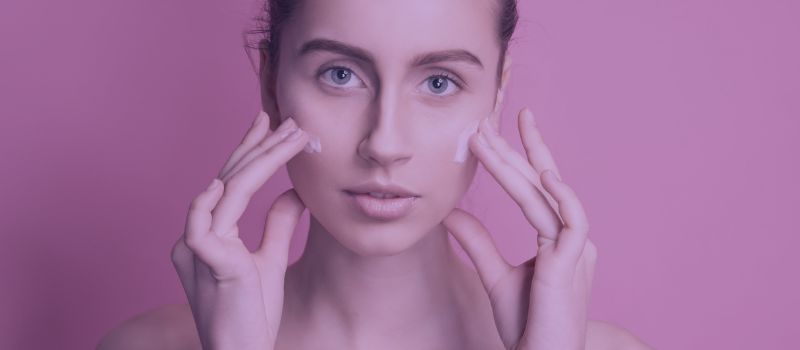• Lactic acid and hyaluronic acid can be used together to improve the skin’s appearance.
• Lactic acid is an exfoliating acid that works by dissolving the protein bonds that hold dead skin cells together on the skin’s surface, resulting in the dead skin cells shedding quicker than they usually would.
• Lactic acid can also unclog superficial clogs that lead to issues like closed comedones and improve the skin’s absorption of other active ingredients.
• Hyaluronic acid is a substance that naturally occurs in the human body and helps keep skin cells plump and hydrated.
• When applied topically to the skin, hyaluronic acid helps reduce water loss and improve moisture levels while also having antioxidant properties that protect against environmental damage.
While these two ingredients have different functions, lactic acid and hyaluronic acid can be used together to improve the skin’s appearance and address many skin concerns, including hyperpigmentation, uneven skin tone and texture, and signs of aging.
However, just like with any skincare combination, it’s important to understand that these two ingredients can irritate if used incorrectly.
Therefore, in this article, I will talk about the benefits of having both ingredients in your skincare regimen as well as how to use lactic acid and hyaluronic acid together for the best results without the risk of irritating your skin.

How Does Lactic Acid Work?
Lactic acid is an exfoliating acid that belongs to the family of alpha-hydroxy acids (AHAs.)
This ingredient is derived from sour milk or sugar-rich foods, and it’s a water-soluble substance with larger molecules that work on the skin’s surface, making lactic acid the gentlest member of the AHAs suitable for all skin types, including sensitive skin.
Lactic acid works by dissolving the protein bonds that hold dead skin cells together on the skin’s surface. This will result in the dead skin cells shedding quicker than they usually would and revealing a smoother, brighter, and more uniform complexion from underneath.
Additionally, lactic acid can also unclog superficial clogs that lead to issues like closed comedones, which are hard, white spots filled with dead skin cells and oil and covered with a thin layer of skin.
Furthermore, due to its exfoliating action, lactic acid can improve the skin’s absorption of other active ingredients, allowing them to penetrate deeper into the skin and have an even better effect.
And finally, lactic acid can also help fade hyperpigmentation and uneven skin tone and brighten the skin’s overall complexion by increasing cell turnover, shedding old, pigmented skin cells, and making room for newer, even-toned cells.
Some benefits of using lactic acid include:
- Smoother and more uniform complexion.
- Improved hyperpigmentation.
- Dissolved closed comedones.
- Evened out skin tone.
- Refined texture.
How Does Hyaluronic Acid Work?
Hyaluronic acid is a substance that naturally occurs in the human body. It can be found all over our bodies, especially around skin cells, as it helps keep them plump and hydrated.
This molecule is also known as a “moisture magnet” since it has an incredibly high capacity for binding and holding onto water molecules, which it uses to keep the skin hydrated.
Additionally, hyaluronic acid makes up about 50% of all glycosaminoglycans (GAGs), which are large molecules known as polysaccharides that deal with the support and maintenance of structural proteins such as collagen and elastin.
When applied topically to the skin, hyaluronic acid helps reduce water loss and improve moisture levels.
It also has antioxidant properties that protect against environmental damage, such as pollution, smoke, and UV radiation.
Hyaluronic acid can also help reduce the appearance of fine lines and wrinkles by making the skin appear plump and bouncy.
Some benefits of using hyaluronic acid include:
- Improved hydration.
- Reduced water loss from the skin.
- Protection against environmental damage.
- Reduced appearance of fine lines and wrinkles.
Risks of Using Lactic Acid and Hyaluronic Acid Together
While using lactic acid and hyaluronic acid together won’t necessarily cause some significant side effects on the skin, there is a potential for both ingredients to be misused, which is a factor that could lead to some problems, such as dry and irritated skin, redness, sensitivity, and peeling.
This is why you need to know how to mix both ingredients in order to get the benefits from each one while minimizing the risk of any adverse effects.
Additionally, bear in mind that lactic acid is an exfoliating acid, and as such, it shouldn’t be used daily. Using lactic acid daily will lead to over-exfoliation, which will cause the skin to become dry, irritated, and sensitive.
How to Use Lactic Acid and Hyaluronic Acid Together?
The best way to use lactic acid and hyaluronic acid together is to apply your lactic acid serum on clean, damp skin and give it a few minutes to dry before spraying a mist that contains hyaluronic acid, like the Eucerin Hydrating Facial Mist and following it up with a lightweight hyaluronic acid serum or a moisturizer.
This is because hyaluronic acid works best when it’s applied on damp skin and followed up with a moisturizer before it fully dries in order to trap in the hydration instead of allowing it to evaporate.
On the other hand, lactic acid needs to be allowed to dry on the skin, as following it up with another product while the skin is still damp can cause the product to move around, which will give you uneven coverage.
And due to how both ingredients work, it’s best to wait a few minutes between applying each one so that you don’t end up with a sticky or tacky feeling on your skin.
More skincare combinations including lactic acid and hyaluronic acid:

My name is Simone and I am a certified skin specialist. I created this website to teach my readers how to take great care of their skin and I also like to occasionally share my honest opinions on skincare products I’ve tried. You can learn more about me here.
